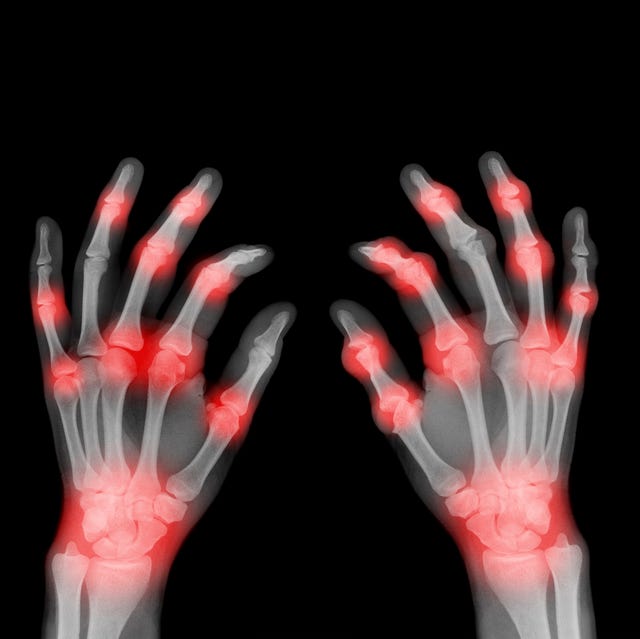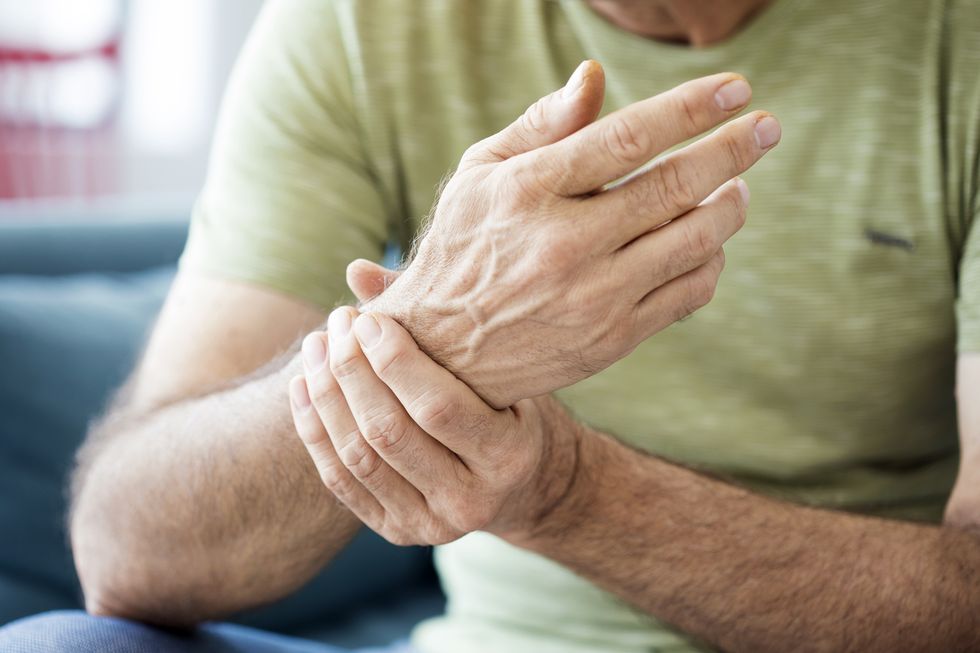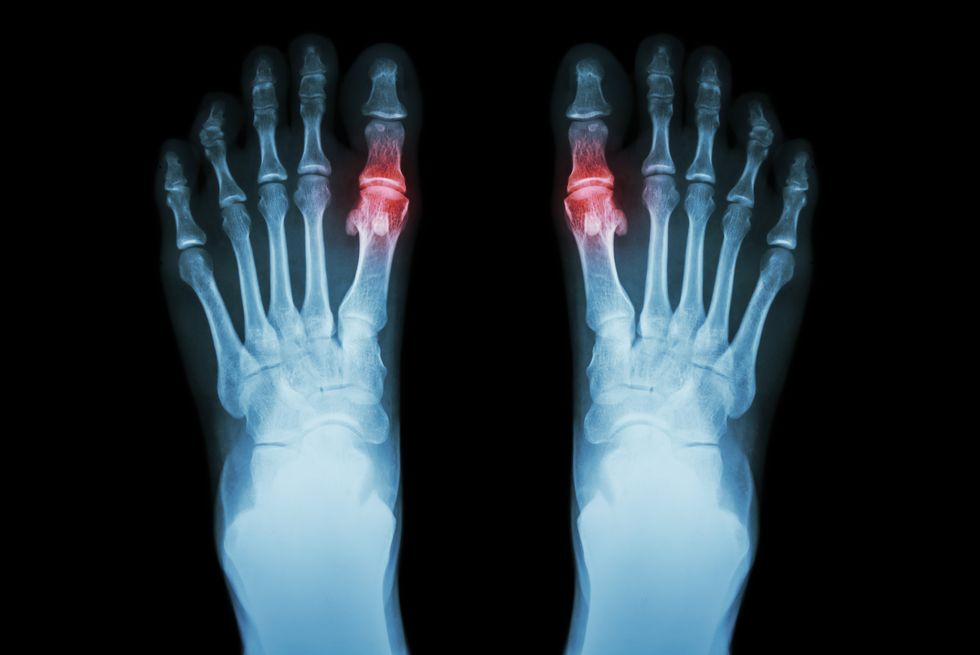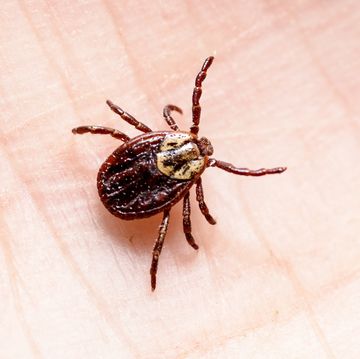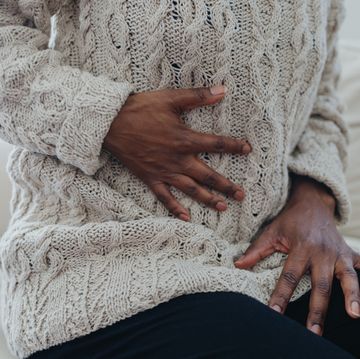Whether you overdid it on the tennis courts or have been typing way too much, there are many reasons why one or more of your joints might be achy.
If you suffer from joint pain, you’re not alone. It’s hard to get exact numbers on how many people struggle with the issue, given that it can be caused by a slew of different things, but one national survey found that up to 30% of adults in the U.S. reported having some form of joint pain in the last 30 days.
Joint pain is defined as experiencing discomfort around one or more of your joints, according to the U.S. National Library of Medicine. While general pain is a common signal, you may also have swelling, warmth, tenderness, redness, and pain with movement around the area.
When the cause of your discomfort is obvious, there’s usually no reason to panic (though you should still see a doctor if it doesn’t go away). But what if your joints hurt and you have no idea why? Or you also have other weird symptoms you can’t explain?
In rare instances, your joint pain might be a signal that something pretty serious is going on, such as a sexually transmitted disease or an autoimmune disorder. But in many cases, it’s likely your joints are hurting due to a more common issue. Here’s a look at some of the conditions that could be making you sore, ranging from the more common to rare.
1. You’re simply getting older.
Your joints have been supporting you your entire life, and that can be hard on them over time—especially when it comes to weight-bearing joints like your knees and hips, says Michael B. Gerhardt, M.D., a sports medicine specialist and orthopedic surgeon at Cedars-Sinai Kerlan-Jobe Institute in Los Angeles. Cartilage, a gel-like substance that helps cushion your joints, also wears down with time, he says.
“Joint pain is extremely common as you age,” Dr. Gerhardt says. “Most of us, if we are fortunate enough to live long enough, will develop some sort of joint pain.”
In addition to your knees and hips, you can also develop joint pain in your shoulders over time. “The source is often repetitive lifting and reaching activities,” says Gregory Gasbarro, M.D., an orthopedic surgeon at The Shoulder, Elbow, Wrist and Hand Center at Mercy Medical Center in Baltimore, Maryland.
2. An older injury is stirring up problems again.
Having an injury earlier in your life—whether it was treated or untreated—can increase your risk of having joint pain later, Dr. Gasbarro says.
There are a few different ways this can happen, but problems like a ligament tear, tendon issues, or a bone fracture can lead to inflammation over time, Dr. Gerhardt says. Even though a doctor can help you manage symptoms, they can’t go back in time and erase the injury. “So, if you had a ligament tear in your knee in your 20s, for example, it sets you up for arthritis 10, 20, or 30 years later,” he says.
3. You’re dealing with bursitis.
Bursitis is the swelling of the bursa, a small, fluid-filled sac that acts like a cushion between a bone and other moving body parts, like your muscles, tendons, or skin, according to the National Institute of Arthritis and Musculoskeletal and Skin Diseases (NIAMS).
Bursitis can cause swelling and pain around your muscles, bones, and joints. Bursa are found in many parts of your body, but bursitis happens the most often in the shoulders, elbows, wrists, hips, knees, and ankles, “In the bursa, there are a high concentration of nerves that create pain when there is swelling and inflammation due to a traumatic or overuse injury,” Dr. Gasbarro says.
You can also develop bursitis from an unrelated injury, like limping after you have low back pain—that can lead to bursitis in your knee or hip, Dr. Gerhardt says.
4. A thyroid issue could be the underlying problem.
Your thyroid is a small, butterfly-shaped gland in the front of your neck, and it makes hormones that control the way your body uses energy. Those hormones impact many different functions in your body, and it “allows your joints and muscles to be lubricated and stay healthy,” Dr. Gerhardt says.
If you have hypothyroidism, your thyroid gland doesn’t make enough of the thyroid hormones that your body needs. “That can adversely affect your joints and make you vulnerable to joint discomfort or injury,” Dr. Gerhardt says.
5. It could be a sign of rheumatoid arthritis.
Rheumatoid arthritis (RA) is different than the wear-and-tear kind (osteoarthritis) that commonly develops with age.
RA is an autoimmune disorder, and it disproportionally targets women: Of the more than 1.3 million people who have it, 75% are female. “It’s worrisome to see in young patients,” says Orrin Troum, M.D., a rheumatologist at Providence Saint John’s Health Center in Santa Monica, Calif. He explains that he’s seen new mothers with such bad inflammation in their hands that they struggle to care for their babies.
Tender, swollen joints and feeling stiff in the morning are classic RA symptoms. You might also have fatigue, fever, or weight loss you can’t explain.
Although not all these causes of joint pain can be cured, they can be treated. Some will require a course of antibiotics or other prescription meds. Others may improve on their own with time and rest. But any lingering pain in your joints should be reason enough to check in with your primary care doctor. They’ll likely refer you to a rheumatologist, a doctor who specializes in arthritis, to make sure you get the right diagnosis and treatment you (and your aching joints) need.
6. Or, it could be infectious (septic) arthritis.
If you get a cut or puncture wound and don’t clean it well with soap and water, “a nearby joint can get infected with common bacteria like Staphylococcus aureus or Streptococcus,” says Dr. Troum. You’ll notice intense swelling and pain in the area, and fever and chills could follow.
Knees are the most commonly affected joint, but hips, ankles, and wrists are also likely targets. You might need IV antibiotics, and your doctor might need to drain fluid from the infected joint. Left untreated, septic arthritis can lead to full-body sepsis, which can be fatal.
7. You may have gout.
Protein is an incredibly important nutrient that helps you stay satiated, build muscle, and feel energized—but you can have too much of a good thing.
“If you eat too much protein, your body produces a lot of uric acid and can’t excrete all of it from your body,” explains Luga Podesta, M.D., a sports medicine physician and regenerative orthopedic specialist in Florida. “This causes an intense inflammatory reaction.”
It’s called gout, and it’s one of the most painful types of arthritis you can experience. Symptoms of gout like heat, swelling, redness, and hard-to-ignore pain commonly appear first in your big toe, then spread to other joints.
Protein overload isn’t the only risk factor. Drinking too much alcohol or sugary drinks, getting dehydrated, or taking certain types of medicines (like beta-blockers) can also bring on a bout of gout. Carrying too much weight puts you at risk as well.
8. Lyme disease could be lurking.
Every year, a reported 30,000 people are bitten by a tick carrying the
Borrelia burgdorferi or Borrelia mayonii bacteria that cause Lyme disease. But the Centers for Disease Control and Prevention believes that true number is much higher—up to 300,000.
“The tick latches onto your skin to suck blood out of your body, but its head has an infection that gets into your bloodstream,” Dr. Podesta explains. Early symptoms of Lyme include fatigue, fever, headache, and in many cases, a bullseye-shaped rash. “Still, it can be difficult to diagnose if you’re not in an area endemic to ticks,” says Dr. Podesta.
If you don’t figure out that you have Lyme disease so you can treat it, the bacteria can spread to your joints, especially your knees. You might also develop neck stiffness and sore hands and feet. Over time, your heart and nervous system may be affected as well.
9. It could be a symptoms of lupus.
Lupus is an autoimmune disorder “can wreck all your joints if left untreated,” says Dr. Troum. People with lupus have an overactive immune system that can mistakenly target joints, as well as skin, blood, kidneys, and other organs.
Along with swollen, painful joints, you may develop a butterfly-shaped rash across your cheeks, but symptoms are different for everyone. Hair loss, trouble breathing, memory problems, mouth sores, and dry eyes and mouth can also be signs of lupus.
10. Gonorrhea could be to blame.
This sexually transmitted disease (STD) doesn’t just affect your genitals; it can also wreak havoc on your joints, as it causes a painful condition called gonococcal arthritis. It affects women more than men and, surprisingly, is most common among sexually active teen girls.
If you have it, you may develop one hot, red, swollen joint (though some people end up with several painful large joints), along with other STD symptoms, says Dr. Troum. Those might include a burning sensation when you urinate, as well as penis discharge or increased vaginal discharge.
Support from readers like you helps us do our best work. Go here to subscribe to Prevention and get 12 FREE gifts. And sign up for our FREE newsletter here for daily health, nutrition, and fitness advice.
